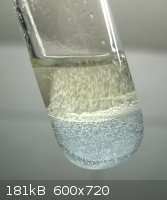woelen
Super Administrator
        
Posts: 7977
Registered: 20-8-2005
Location: Netherlands
Member Is Offline
Mood: interested
|
|
Nice effect, dissolving NOx in ligroin
I did a little experiment, trying to see how well NO2 dissolves in ligroin. It doesn't, but during the experiment I made a picture and I think it is
nice enough to share with others.
The experiment is simple:
- Prepare a cold solution of NaNO2 in water in a test tube.
- Pour some low-boiling ligroin (alkane mix, mostly C7, C8) on top of this solution.
- Pour some cold dilute (appr. 2 M) sulphuric acid in the test tube and swirl for some time.
The result is a pale blue solution, in which many bubbles of gas are produced. These bubbles of gas collect at the interface layer between water and
ligroin and then larger bubbles move through the ligroin at a much higher velocity (these bubbles are larger and the liquid most likely is less
viscous). After some time, the ligroin layer turns pale yellow, due to dissolved NO2.
After a much longer time, the air above the liquids is brown, but the ligroin itself (also after shaking) does not turn darker, it remains pale
yellow. NO2 does not dissolve well in ligroin.
I made a picture when the liquid was still nice pale blue and many small bubbles were produced. The picture nicely shows the effect of higher speed of
bubbles in the ligroin layer (which is on top and which is pale yellow).
This experiment is nothing really special, but it is nice and can be done with fairly common chemicals.

|
|
|
Poppy
Hazard to Others
  
Posts: 294
Registered: 3-11-2011
Member Is Offline
Mood: † chemical zombie
|
|
Cool! Which layer holds the acidic solution on that picture of yours? Can you show us that one picture where you affirmed seeing a blue solution of
the mixed acid?
|
|
|
woelen
Super Administrator
        
Posts: 7977
Registered: 20-8-2005
Location: Netherlands
Member Is Offline
Mood: interested
|
|
The lower pale blue layer is the acidic layer, which contains HNO2. Solutions of HNO2 are pale blue.
|
|
|
papaya
National Hazard
   
Posts: 615
Registered: 4-4-2013
Member Is Offline
Mood: reactive
|
|
I've heard turpentine catches fire when contacting with nitric acid, what will happen if you replace ligroin with it?
|
|
|
starman
Hazard to Others
  
Posts: 318
Registered: 5-7-2008
Location: Western Australia
Member Is Offline
Mood: No Mood
|
|
Quote: Originally posted by woelen  | | The lower pale blue layer is the acidic layer, which contains HNO2. Solutions of HNO2 are pale blue. |
It is my understanding that the blue colour is the result of the decomposition product of HNO2 Dinitrogen trioxide,N2O3 which form very vivid blue
liquid at low temperature (-21C from memory)
Interestingly psuedonitrosite preparations utilised the equimolar NO/NO2 mixture from this at the beginning of the 20th century.
This was often fed to the substrate in a mix of ligroin/ether.Given its insolubility in ligroin I wonder at its use for this application.(excluding as
a cosolvent-substrates were completely solved in ether)
Chemistry- The journey from the end of physics to the beginning of life.(starman)
|
|
|